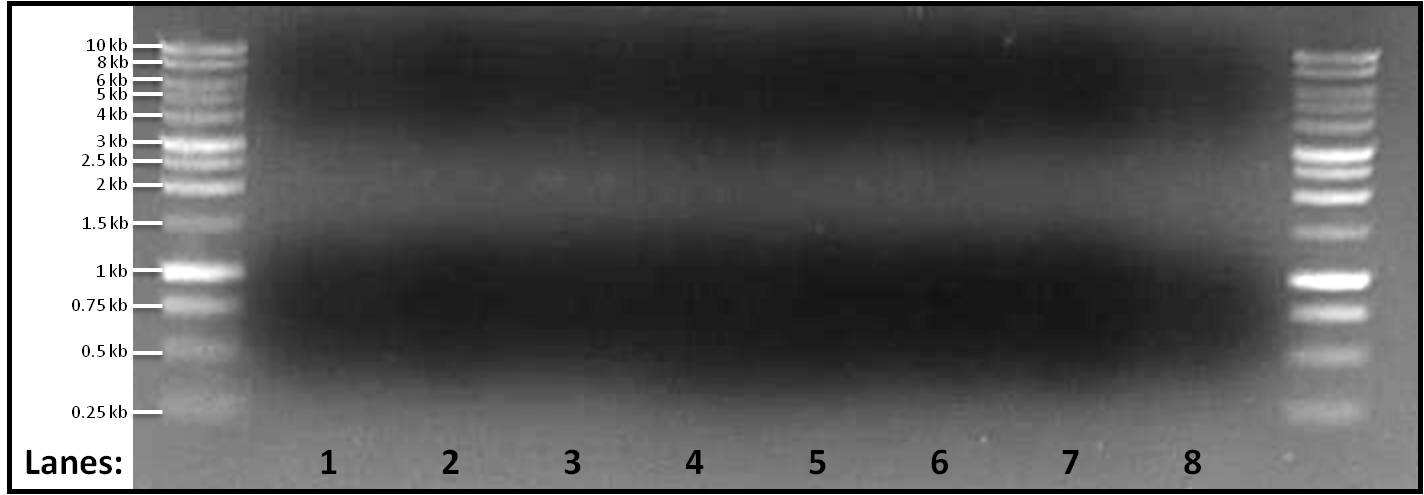Team:Newcastle/23 August 2010
From 2010.igem.org
Shethharsh08 (Talk | contribs) (→Conclusion) |
Shethharsh08 (Talk | contribs) |
||
| Line 1: | Line 1: | ||
{{Team:Newcastle/mainbanner}} | {{Team:Newcastle/mainbanner}} | ||
| + | =pSB1C3 plasmid gel electrophoresis= | ||
| + | |||
| + | ==Aims== | ||
| + | The aim of this experiment is to run gel electrophoresis for the extracted and linearized plasmid pSB1C3 fragment which were amplified at 4 different melting temperatures by 4 separate PCR reactions. | ||
| + | |||
| + | ==Materials and Protocol== | ||
| + | Please refer to: [[Team:Newcastle/Gel electrophoresis| gel electrophoresis]] for gel electrophoresis protocol. | ||
| + | |||
| + | ==Result== | ||
| + | [[Image:Newcastle Gel 1 - 23-08-2010.jpg|700px|centre]] | ||
| + | |||
| + | |||
| + | '''Figure 1''': Gel electrophoresis of the amplified linearized plasmid pSB1C3 fragments ran at 4 different melting temperatures, Tms, (50, 60, 65, 70°C). A 1 kb DNA ladder was used on either side of lanes. | ||
| + | * '''Lane 1''': pSB1C3 fragment amplified at 55°C | ||
| + | * '''Lane 2''': pSB1C3 fragment amplified at 60°C | ||
| + | * '''Lane 3''': pSB1C3 fragment amplified at 65°C | ||
| + | * '''Lane 4''': pSB1C3 fragment amplified at 70°C | ||
| + | * '''Lane 5''': pSB1C3 fragment amplified at 55°C | ||
| + | * '''Lane 6''': pSB1C3 fragment amplified at 60°C | ||
| + | * '''Lane 7''': pSB1C3 fragment amplified at 65°C | ||
| + | * '''Lane 8''': pSB1C3 fragment amplified at 70°C | ||
| + | |||
| + | ==Discussion== | ||
| + | No bands were found in any of the lanes. Yesterday, a faint band was found when the melting temperature was set at 65°C but today no band is found in lane 3 and lane 7. This makes finding the cause for no amplification even difficult. We would still be looking into it and would be changing other parameters. | ||
| + | |||
| + | ==Conclusion== | ||
| + | The PCR reaction failed as there is no amplification found in any of the reactions. | ||
| + | |||
| + | |||
=pSB1C3 plasmid gel electrophoresis= | =pSB1C3 plasmid gel electrophoresis= | ||
Revision as of 16:28, 24 August 2010

| |||||||||||||
| |||||||||||||
Contents |
pSB1C3 plasmid gel electrophoresis
Aims
The aim of this experiment is to run gel electrophoresis for the extracted and linearized plasmid pSB1C3 fragment which were amplified at 4 different melting temperatures by 4 separate PCR reactions.
Materials and Protocol
Please refer to: gel electrophoresis for gel electrophoresis protocol.
Result
Figure 1: Gel electrophoresis of the amplified linearized plasmid pSB1C3 fragments ran at 4 different melting temperatures, Tms, (50, 60, 65, 70°C). A 1 kb DNA ladder was used on either side of lanes.
- Lane 1: pSB1C3 fragment amplified at 55°C
- Lane 2: pSB1C3 fragment amplified at 60°C
- Lane 3: pSB1C3 fragment amplified at 65°C
- Lane 4: pSB1C3 fragment amplified at 70°C
- Lane 5: pSB1C3 fragment amplified at 55°C
- Lane 6: pSB1C3 fragment amplified at 60°C
- Lane 7: pSB1C3 fragment amplified at 65°C
- Lane 8: pSB1C3 fragment amplified at 70°C
Discussion
No bands were found in any of the lanes. Yesterday, a faint band was found when the melting temperature was set at 65°C but today no band is found in lane 3 and lane 7. This makes finding the cause for no amplification even difficult. We would still be looking into it and would be changing other parameters.
Conclusion
The PCR reaction failed as there is no amplification found in any of the reactions.
pSB1C3 plasmid gel electrophoresis
Aims
The aim of this experiment is to run gel electrophoresis for the extracted and linearized plasmid pSB1C3 fragment which were amplified at 4 different melting temperatures by 4 separate PCR reactions.
Materials and Protocol
Please refer to: gel electrophoresis for gel electrophoresis protocol.
Result
Figure 1: Gel electrophoresis of the amplified linearized plasmid pSB1C3 fragments ran at 4 different melting temperatures, Tms, (50, 60, 65, 70°C). A 1 kb DNA ladder was used on either side of lanes.
- Lane 1: pSB1C3 fragment amplified at 55°C
- Lane 2: pSB1C3 fragment amplified at 60°C
- Lane 3: pSB1C3 fragment amplified at 65°C
- Lane 4: pSB1C3 fragment amplified at 70°C
- Lane 5: pSB1C3 fragment amplified at 55°C
- Lane 6: pSB1C3 fragment amplified at 60°C
- Lane 7: pSB1C3 fragment amplified at 65°C
- Lane 8: pSB1C3 fragment amplified at 70°C
Discussion
No bands were found in any of the lanes. Yesterday, a faint band was found when the melting temperature was set at 65°C but today no band is found in lane 3 and lane 7. This makes finding the cause for no amplification even difficult. We would still be looking into it and would be changing other parameters.
Conclusion
The PCR reaction failed as there is no amplification found in any of the reactions.
 
|
 "
"
